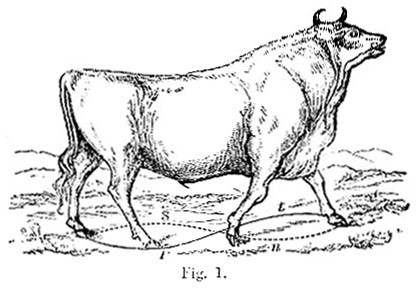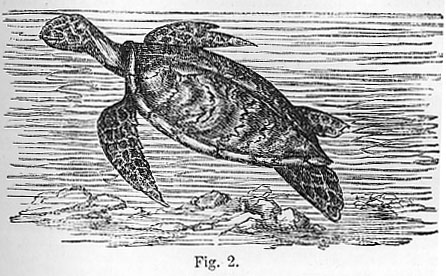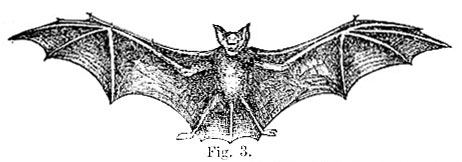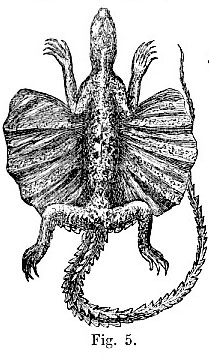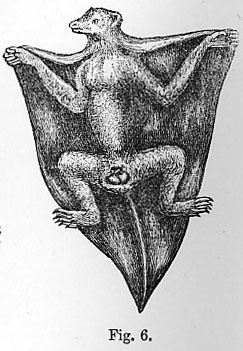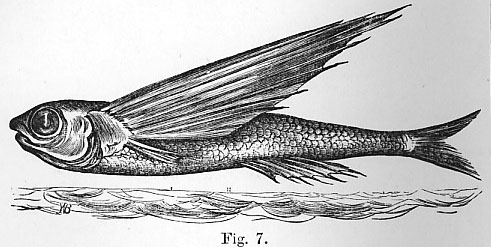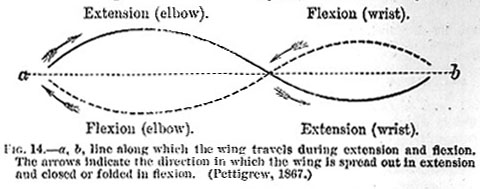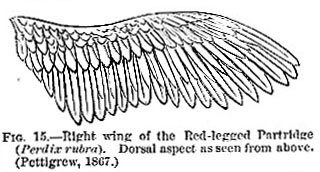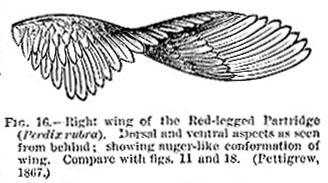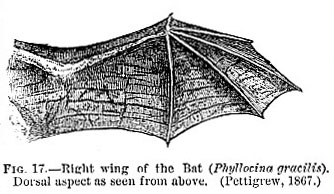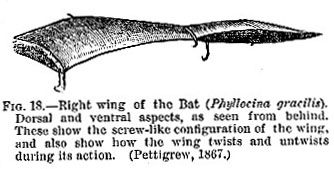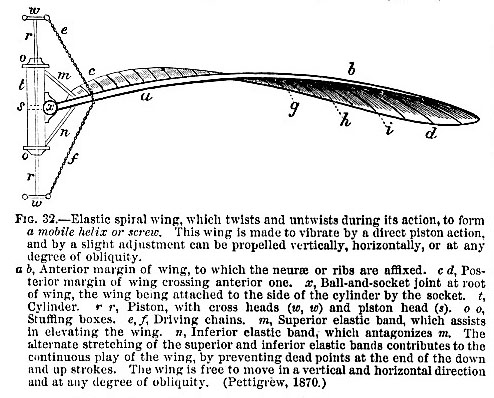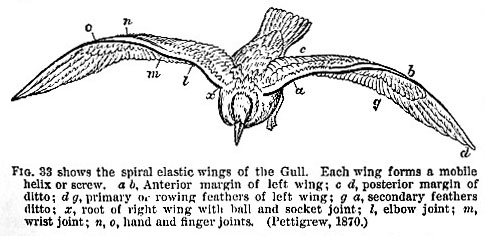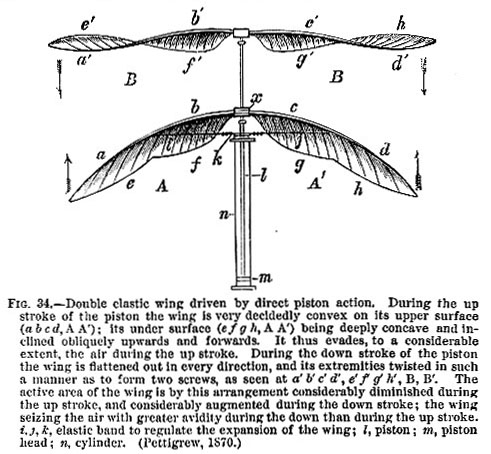1902 Encyclopedia > Flight, Flying Machines
Flight, Flying Machines
Of the many scientific problems a modern times, there are few possessing a wider or more enduring interest than that of aerial navigation. To fly has always been an object of ambition with man; nor will this occasion surprise when we remember the marvelous freedom enjoyed by Volant as compared with non-volant animals. The traditions of Daedalus and Icarus illustrate the attempts in the past; and at the present day societies exist in Britain, France, Austria, and other countries, for the purpose of solving, if possible, the knotty problem. These societies embrace men of the highest scientific attainments, and as they evince great activity, and publish their proceedings at regular intervals, it is not too much to expect that the problem of artificial flight will be actually solved, or at least much simplified. For the first time in the history of the world, the subject of aerial navigation has been taken up in earnest by practical men with the necessary degree of preliminary knowledge and training. Investigators no longer dream about flight: they experiment upon and work towards it. It is, they maintain, a physical problem to be solved by mechanical skill and ingenuity. But while writing thus hopefully, it is necessary to state that as yet no one has succeeded in constructing a fully equipped flying machine. The number of successful flying models, however, is so considerable as to inspire the cultivators of aeronautical science with a very confident hope of success.
The object of the present article is threefold – (1) to demonstrate the laws of natural flight; (2) to expound the principles on which a flying machine should be constructed; and (3) to chronicles some of the more important attempts at aerostation in modern times.
It is not necessary to enter upon a history of artificial flight. This has already been done in the article Aeronautics, to which the reader is referred. The fact is that aerostation in its modern form dates back only a very few years. It will suffice, then, if the modern discoveries are recorded in the order of time as we proceed.
The subject of aerostation is admitted on all hands to be one of extreme difficulty. To tread upon the air (and this is what is really meant) is, at first sight, in the highest degree utopian; and yet there are thousands of living creatures which actually accomplish this feat. These creatures, however varied in form and structure, all fly according to one and the same principle; and this is a significant fact, as it tends to show that the air must be attacked in a particular way to ensure flight. The flying machine of the future, there can be no doubt, will be constructed on the type of flying animals, - the insect, bird, and bat. It behoves us then at the outset to scrutinize very carefully the general configuration of flying animals, and in particular the size, shape, and movements of their flying organs.
Flying animals, it may be premised, differ entirely from sailing ships and from balloons, with which they are not unfrequently though erroneously compared; and a flying machine constructed upon proper principles can have nothing in common with either of those creations. The ship floats upon water and the balloon upon air; but the ship differs from the flying creature and flying machine. The water and air, moreover, have characteristics of their own. The analogies which connect the water with ther air, the ship with the balloon, and the ship and the balloon with the flying creature and flyuing machine are false analogies. A sailing ship is supported by the water and requires merely to be propelled; a flying creature and a flying machine constructed on the living type require to be both supported and propelled. This arises from the fact that water is much denser than air, and because water supports on its surface substances which fall through air.
While water and air are both to be regard as fluid media, they are to be distinguished from each other in the following particulars. Water is comparatively very heavy, inelastic, and incompressible; air, on the other hand, is comparatively very light, elastic, and compressible. If water he struck with violence, the recoil obtained is great when compared with the recoil obtained from air similarly treated. In water we get a maximum recoil with a minimum of displacement; in air, on the contrary, we obtain a minimum recoil with a maximum of displacement.
Water and air when unconfined yield readily to pressure. They thus form movable fulcra to bodies acting upon them. In order to meet these peculiarities the traveling organs of aquatic and flying animals (whether they be feet, fins, flippers, or wings) are made not of rigid but of elastic materials. The traveling organs, moreover, increase in size in proportion to the tenuity of the fluid to be acted upon. The difference in size of the traveling organs of animals become very marked when the land animals are contrasted with the aquatic, and the aquatic with the aerial, as in figs. 1, 2, and 3.
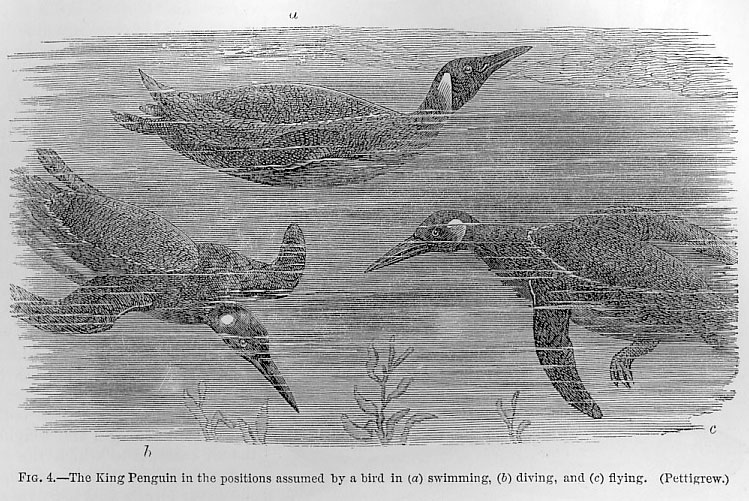
The peculiarities of water and air as supporting media are well illustrated by a reference to swimming, diving, and flying birds. A bird when swimming extends its feet simultaneously or alternately in a backward direction, and so obtains a forward recoil. The water supports the bird, and the feet simply propel. In this case the bird is lighter than the water, and the long axis of the body is horizontal (a of fig. 4). When the bird dives or flies under water, the long axis of the body is inclined obliquely downwards and forwards, and the bird forces itself into and beneath the water by the action of its feet, or wings, or both. In diving or subaquatic flight the feet strike upwards, and backwards, the wings downwards and backwards (b of fig. 4). In aerial flying everything is reversed. The long axis of the bird in inclined obliquely upwards and forwards, and the wings strike, not downwards and backwards, but downwards and forwards (c of fig. 4). These changes in the direction of the long axis of the bird in swimming, diving, and flying, and in the direction of the stroke of the wings in subaquatic and aerial flight, are due to the fact that the bird is heavier than the air and lighter than the water.
The physical properties of water and air explain in a great measure how the sailing ship differs from the balloon, and how the latter differs from the flying creature and flying machine constructed on the natural type. The sailing ship is, as it were, immersed in two oceans, - viz., an ocean of water and an ocean of air-the former being greatly heavier and denser than the latter. The ocean of water buoys or floats the ship, and the ocean of air, or part of it in motion, swells the sails which propel the ship. The moving air which strikes the sails directly strikes the hull of the vessel indirectly and forces it through the water, which, as explained, is a comparatively dense fluid. When the ship is in motion it can be steered either by the sails alone, or by the rudder alone, or by both combined. A balloon differs from a sailing ship in being immersed in only one ocean, viz., the ocean of air. It resembles the ship in floating upon the air, as the ship floats upon the water; in other words, the balloon is lighter than the air, as the ship is lighter than the water. but here all analogy ceases. The ship, in virtue of its being immersed in two fluids having different densities, can be steered and made to tack about in a horizontal plane in any given direction. This in the case of the balloon, immersed in one fluid, is impossible. The balloon in a clam can only rise and fall in a vertiucal line. Its horizontal movements, which ought to be the more important, are accidental movements due to air currents, and cannot be controlled; the balloon, in short, cannot be guided. One might as well attempt to steer a boat carried along by currents of water in the absence of oars, sails, and wind, as to steer a balloon carried along by currents of air. The balloon has no hold upon the air, and this consequently cannot be employed as a fulcrum for regulating its course. The balloon, because of its vast size and from its being lighter than the air, is completely at the mercy of the wind. It forms an integral part, so to speak, of the wind for the time being, and the direction of the wind in every instance determines the horizontal motion of the balloon. The force required to propel a balloon against even a moderate breeze would result in its destruction. The balloon cannot be transferred with any degree of certainty from one point of the earth’s surface to another, and hence the chief danger in its employment. It may, quite as likely as not, carry its occupants out to sea. The balloon is a mere lifting machine. It has no analogue in nature, and, as its history sufficiently shows, is incapable of improvement.
The balloon, as is well known, was introduced by the Montgolfier brothers in 1782. It was first inflated by heated air obtained by burning trusses of straw under it, then by hydrogen gas, and lastly by coal gas. It is in no sense to be regarded a flying machine. It resembles the flying creature only in this that it is immersed in the ocean of air in which it sustains itself. The mode of suspension is wholly different. The balloon floats because it is lighter than the air; the flying creature floats because it extracts from the air, by the vigorous downward action of its wings, a certain amount of upward recoil. The balloon is passive; the flying creature is active. The balloon is controlled by the wind; the flying creature controls the wind. The balloon in the absence of wind can only rise and fall in a vertical line; the flying creature can fly in a horizontal plane in any given direction. The balloon is inefficient because of its levity; the flying creature is efficient because of its weight.
Weight, however paradoxical it may appear, is necessary to flight. Everything which flies is vastly heavier than the air. The inertia of the mass of the flying creature enables it to control and direct its movements in the air. many are of opinion that flight is a mere matter of levity and power. This is quite a mistake. No machine, however light and powerful, will every flu whose traveling surfaces are not properly fashioned and properly applied to the air.
It was supposed at one time that the air sacs of birds contributed in some mysterious way to flight, but this is now known to be erroneous. The bats and some of the best-flying birds have no air sacs. Similar remarks are to be made of the heated air imprisoned within the bones of certain birds. Feathers even are not necessary to flight. Insects and bats have no feathers, and yet fly well. The only facts in natural history which appear even in directly to countenance the flotation theory are the presence of a swimming bladder in some fishes, and the existence of membranous expansions or pseudo-wings in certain animals, such a the flying fish, flying dragon, and flying squirrel. As, however, the animals referred to do not actually fly, but merely dart into the air and there sustain themselves for brief intervals, they afford no real support to the theory. The so-called floating animals are well depicted at figs. 5, 6 and 7.
It has been asserted, and which some degree of plausibility, that a fish lighter than the water might swim, and that a bird lighter than the air might fly; it ought, however, to be borne in mind that, in point of fact, a fish lighter than the water could not hold its own if the water were in the least perturbed, and that a bird lighter than the air would be swept into space by even a moderate breeze without hope of return. Weight and power are always associated in living animal, and the fact that living animals are made heavier than the medium they are to navigate may be regarded as a conclusive argument in favor of weight being necessary alike to the swimming of the fish and the flying of the bird. It may be stated once for all that flying creatures are for the most part as heavy, bulk for bulk, as other animals, and that flight in every instance is the product, not of superior levity, but of weight and power directed upon properly constructed flying organs.
This fact is important as bearing on the construction of flying machines. It shows that a flying machine need not necessarily be a light, airy structure exposing an immoderate amount of surface. On the contrary, it favors the belief that it should be a compact and moderately heavy and powerful structure, which trusts for elevation and propulsion entirely to its flying appliances-whether actively moving wings, or screws, or aero-planes wedged forward by screws. It should attack and subdue the air, and never give the air an opportunity of attacking or subduing it. It should smite the air intelligently and as a master, and its vigorous well-directed thrusts should in every instance elicit an upward and forward recoil. The flying machine of the future, there is reason to believe, will be a veritable example of "multum in parvo." It will launch itself in the oceanof air, and will extract from that air, by means of its traveling surfaces-however fashioned and however applied-the recoil or resistance necessary to elevate and carry it forward. Extensive inert surfaces indeed are contra-indicated in a flying machine, as they approximate, it to the balloon, which, as has been shown, cannot maintain its position in the air if there are air currents. A flying machine which could not face air currents would necessarily be a failure. To obviate this difficulty we are forced to fall back upon weight, or rather the structures and appliances which weight represents. These appliances as indicated should not be unnecessarily expanded, be converted into actively moving flying surfaces, in preference to fixed or inert dead surfaces.
The question of surface is a very important one in aerostation: it naturally resolves itself into one of active and passive surface. As there are active and passive surfaces in the flying animal, so there are active and passive surfaces in the flying animal, so there are, or should be, active and passive surfaces in the flying machine. Art should follow nature in this matter. The active surfaces in flying creatures are always greatly in excess of the passive ones, from the fact that the former virtually increase in proportion to the spaces through which they are made to travel. Nature not only distinguishes between active and passive urfaces in flying animals, but she strikes a just balance between them, and utilizes both. She regulates the surfaces to the strength and weight of the flying creature and the air currents to which the surfaces are to be exposed and upon which they are to operate. In her calculations she never forgets that her flying subjects are to control and not to be controlled by the air., as a rule she reduces the passive surfaces of the body to a minimum; she likewise reduces as far as possible the actively moving or flying surfaces. While, however, diminishing the surfaces of the flying animal as a whole, she increases as occasion demands the active or wing surfaces by wing movements, and the passive or dead surfaces by the forward motion of the body in progressive flight. She knows that if the wings are driven with sufficient rapidity they practically convert the spaces through which they move into solid bases of support; she also knows that the body in rapid flight derives support from all the air over which it passes. The manner in which the wing surfaces are increased by the wing movements will be readily understood from the accompanying illustrations of the flow by with its wings at rest and in motion (figs. 8 and 9).
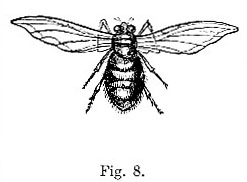
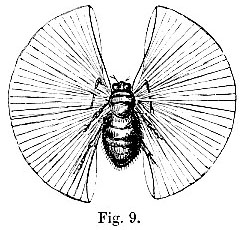
In fig. 8 the surfaces exposed by th body of the insect and the wings are, as compared with those of fig. 9, trifling. The wind would have much less purchase on fig. 8 than on fig. 9, provided the surfaces exposed by the latter were passive or dead surfaces. But they are not dead surfaces: they represent the spaces occupied by the rapidly vibrating wings, which are actively moving flying organs. As, moreover, the wings travel at a much higher speed than any wind that blows, they are superior to and control the wind; they enable the insect to dart through the wind in whatever direction it pleases.
The reader has only to imagine figs. 8 and 9 cut out in paper to realize that extensive, inert horizontal aero-planes in a flying machine would be a mistake. It is found to be so practically, as will be shown by and by. Fig. 9 so cut out would be heavier than fig. 8, and if both were exposed to a current of air, fig. 9 would be more blown about than fig. 8.
It is true that in beetles and certain other insects there are the elytra or wing cases-thin, light, horny structures – which in the act of flight are extended horizontally and act as sustainers or gliders. The elytra, however, are comparatively long narrow structures which occupy a position in front of the wings, of which they may be regarded as forming the anterior parts. The elytra are to the delicate wings of some insects what the thick anterior margins are to stronger wings. The elytra, moreover, are not wholly passive structures. They can be moved, and the angles made by their under surfaces with the horizon adjusted. Finally, they are not essential to flight, as flight in the great majority of instances in performed without them. the elytra serve as protector to the wings when the wings are folded upon the back of the insect, and as they are extended horizontally when the insect is flying they contribute to flight indirectly, in virtue of their being carried forward by the body in motion.
The manner in which the wings of the insect traverse the air, so as practically to increase the basic of support, raises the whole subject of natural flight. It is necessary, therefore, at this stage to direct the attention of the reader somewhat fully to the subject of flight, as witnessed in the insect, bat, and bird,- a knowledge of natural flight preceding, and being in some senses indispensable to, a knowledge of artificial flight.
The bodies of flying creatures are, as a rule, very strong, comparatively light, and of an elongated form, - the bodies of birds being specially adapted for cleaving the air. flying creatures, however, are less, remarkable for their strength, shape, and comparatively levity thanfor the size and extraordinarily rapid and complicated movements of their wings. To Professor J. Bell Pettigrew is due the merit of having first satisfactorily analyzed those movements, and of having reproduced them by the aid of artificial wings. This physiologist in 1867 showed that all natural wings, whether of the insect, bat, or bird, are screws structurally, and that they act as screws when they are made to vibrate, from the fact that they twist in opposite directions during the down and up strokes. He also explained that all wings act upon a common principle, and that they present oblique, kite-like surfaces to the air, through which they pass much in the same way that an oar passes through water in seculling. He further pointed out that the wings of flying creatures (contrary to received opinions, and as has been already indicated) strike downwards and forwards during the down strokes, and upwards and forwards during the up strokes. Lastly, and most important of all, he demonstrated that the wings of flying creatures, when the bodies of said creatures are fixed describe figure-of-8 tracks in space, - the figure-of-8 tracks, when the bodies are released and advancing as in rapid flight, being opened out and converted into waved tracks.
Professor Pettigrew’s discovery of the figure-of-8 and waved movements, concerning which so much has been said and written, was confirmed some two years after it was made by professor E.J. Marey by the aid of the "sphygmograph." The movements in question are now regarded as fundamental from the fact that they are alike essential to natural and artificial flight.
The following is Professor Pettigrew’s decription of wings and wing movements published in 1867:-
"The wings of insects and birds are, as a rule, more or less triangular in shape, the base of the triangle being directed towards the body, its sides anteriorly and posteriorly. They are also conical on section from within outwards and from before backwards, this shape converting the pinions into delicately-graduated instruments balanced with the utmost nicety to satisfy the requirements of the muscular system on the one hand and the resistance and resiliency of the air on the other. While all wings are graduated as explained, innumerable varieties occur as to their general contour, some being falcated or scythe-like, others oblong, others rounded or circular, some lanceolate, and some linear. The wings of insects may consist either of one or two pairs, - the anterior or upper pair, when two are present, being in some instances greatly modified and presenting a corneous condition. They are then known as elytra, from the Greek, a sheath. Both pairs are composed of a duplicature of the integument, or investing membrane, and are strengthened in various directions by a system of hollow, horny tubes, known to entomologists as the neurae or nervures. These nervures taper towards the extremity of the wing, and are strongest towards its root and anterior margin, where they supply the place of the arm in bats and birds. The neurae are arranged at the axis of the wing after the manner of a fan or spiral stair, - the anterior one occupying a higher position than that farther back, and so of the others. As this arrangement extends also to the margins, the wings are more or less twisted upon themselves, and present a certain degree of convexity on their superior or upper surface, and a corresponding concavity on their interior or under surface, - their free edges supplying those fine curves which act with such efficacy upon the air in obtaining the maximum of resistance and the minimum of displacement. As illustrative examples of the form of wings alluded to, those of the beetle, bee, and fly may be cited, - the pinions in those insects acting as helices, or twisted levers, and elevating weights much greater than the area of the wings would seem to warrant" (figs. 10 and 11).
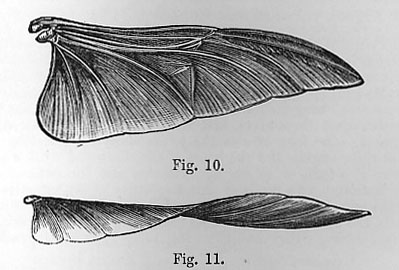
....."To confer on the wings the multiplicity of movements which they require, they are supplied with double hinge or compound joints, which enable them to move not only in an upward, downward, forward, and backward direction, but also at various intermediate degrees of obliquity. An insect with wings thus hinged may, as far as steadiness of body is concerned, be not inaptly compared to a compass set upon gimbals, where the universality of motion in one direction ensures comparative fixedness in another."
....."All wings obtain their leverage by presenting oblique surfaces to the air, the degree of obliquity gradually increasing in a direction from behind, forwards and downwards, during extension when the sudden or effective stroke is being given, and gradually decreasing in an opposite direction during flexion, or when the wing is being more slowly recovered preparatory to making a second stroke. The effective stroke in insects, and this holds true also of birds, is therefore delivered downwards and forwards, and not, as the majority of writers believe, vertically, or even slightly backwards.
.....The wing in the insect is more flattered than in the bird; and advantage is taken on some occasions of this circumstance, particularly in heavy-bodied, small-winged, quick-flying insects, to reverse the pinion more or less completely during the down and up strokes." ………" this is effected in the following manner. The posterior margin of the wing is made to rotate, during the down stroke, in a direction from above downwards and from behind forwards,-the anterior margin traveling in an opposite direction and reciprocating. The wing may thus be said to attack the air by a screwing movement from above. During the up or return stroke, on the other hand, the posterior margin rotates in a direction from below upwards and from before backward, so that by a similar but reverse screwing motion the pinion attacks the air from beneath."…………."A figure-of-8, compressed laterally and placed obliquely with its long axis running from left to right of the spectator, represents the movements in question. The down and up strokes, as will be seen from this account, cross each other, the wing smiting the air during its descent from above, as in the bird and bat, and during its ascent from below as in the flying fish and boy’s kite (fig. 12).

……… "The figure –of-8 action of the wing explain how an insect or bird fix itself in the air, the backward and forward reciprocating action of the pinion affording support, but no propulsion. In these instances the backward and forward strokes are made to counterbalance each other. Although the figure-of-8 represnets with considerable fidelity the twisting of the wing upon its axis during extension and flexion, when the insect is playing its wings before an object, or still better when it is artificially fixed, it is otherwise when the down stroke is added and the insect is fairly on the wing and progressing rapidly. In this case the wing, in virtue of its being carried forward by the body in motion, describes an undulating or spiral course, as shown in fig. 13."

……. "The down and up strokes are compound movements- the termination of the down stroke embracing the beginning of the up stroke, and the termination of the up stroke including the beginning of the down stroke. This is necessary in order that the down and up strokes may glide into each other in such a manner as to prevent jerking and unnecessary retardation."……
"The wing of the bird, like that of the insect, is concavo-convex, and more or less twisted upon itself when extended, so that the anterior or thick margin of the pinion presents a different degree of curvature to that of the posterior or thin margin. This twisting is in a great measure owing to the manner in which the bones of the wing are twisted upon themselves, and the spiral nature of their articular surfaces,- the long axes of the joints always intersecting each other at right angles, and the bones of the elbow and wrist making a quarter of a turn so during extension and the same amount during flexion. As a result of this disposition of the articular surfaces, the wing may be shot out or extended, and retracted or flexed in nearly the same plane, the bones composing the wing rotating on their axes during either movement (fig. 14.) The secondary action, or the revolving of the component bones on their own axes, is of the greatest importance in the movements of the wing, as it communicates to the hand and forearm, and consequently to the primary and secondary feathers which they bear, the precise angles necessary for flight. It in fact ensures that the wing, and the curtain or fringe of the wing which the primary and secondary feathers form, shall be screwed into and down upon the wind in extension, and unscrewed or withdrawn from the wind during flexion. The wing of the bird may therefore be compared to a huge gimlet or auger, the axis of the gimlet representing the bones of the wing, the flanges or spiral thread of the gimlet the primary and secondary feathers" (figs. 15 and 16)….. "From this description it will be evident that by the mere rotation of the bones of the forearm and hand the maximum and minimum of resistance is secured much in the same way that this object is attained by the alternate dipping and feathering of an oar." ……….. "The wing, both when at rest and when in motion, may not inaptly be compared to the blade of an ordinary screw propeller as employed in navigation. Thus the general outline of the wing corresponds closely with the outline of the propeller (figs, 11, 16 and 18). And the track described by the wing in space is twisted upon itself propelled fashion (figs. 12, 20, 21, 22, 23). The great velocity with which the wing is driven converts the impression or blur into what is equivalent to a solid for the time being, in the same way that the spokes of a wheel in violent motion, as is well understood, more or less completely occupy the space contained within the rim or circumstance of the wheel" (figs. 9, 20, and 21).
……. "The wing of the bat bears considerable resemblance to that of the insect, inasmuch as it consists of a delicate, semi-transparent, continuous membrane, supported in divers directions, particularly towards its anterior margin, by a system of stay or stretchers which confer upon it the degree of rigidity requisite for flight. It is, as a rule, deeply concave on its under or ventral surface, and in this respect resembles the wing of the heavy-bodied birds. The movement of the bat’s wing in extension is a spiral one, the spiral running alternately from below upwards and forwards and from above downwards and backwards. The action of the wing of the bat, and the movements of its component bones, are essentially the same as in the bird (figs. 17 and 18).
……. "The wing strikes the air precisely as a boy’s kite would if it were jerked by its string, the only difference being that the kite is pulled forwards upon the wind by the string and the hand, whereas in the insect, bat, and bird the wing is pushed forwards on the wind by the weight of the body and the power residing in the pinion itself" (fig. 19).
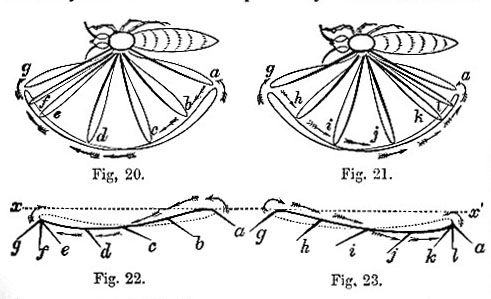
The figure –of-8 and kite-like action of the wing referred to lead us to explain how it happens that the wing, which in many instances is a comparatively small and delicate organ, can yet attack the air with such vigor as to extract from it the recoil necessary to elevate and propel the flying creature. The accompanying figures from one of Professor Pettigrew’s more recent memoirs will serve to explain the rationale (figs. 20, 21, 22, and 23).
As will be seen from these figures, the wing during its vibration sweeps through a comparatively very large space. This space, as already explained, is practically a solid basis of support for the wing and for the flying animal. The wing attacks the air in such a manner as virtually to have no slip, - this for two reasons. The wing reverses instantly and act as a kite during nearly the entire down and up strokes. The angles, moreover, made by the wing with the horizon during the down and up strokes are at no two intervals the same, but (and this is a remarkable circumstance) they are always adapted to the speed at which the wing is traveling for the time being. The increase and decrease in the angles made by the wing as it hastens to and fro are due partly to the resistance offered by the air, and partly to the mechanism and mode of application of the wing to the air. The wing, during its vibrations, rotates upon two separate centers, the tip rotating round the root of the wing as an axis (short axis of wing), the posterior margin rotating around the anterior margin (long axis of wing). The wing is really eccentric in its nature, a remark which applies also to the rowing feathers of the bird’s wing. The compound rotation goes on throughout the entire down and up strokes, and is intimately associated with the power which the wing enjoys of alternately seizing and evading the air.
The compound rotation of the wing is greatly facilitated by the wing being elastic and flexible. It is this which causes the wing to twist and untwist diagonally on its long axis when it is made to vibrate. The twisting referred to is partly a vital and partly a mechanical act; - that is, it is occasioned on part by the action of the muscles and in part by the greater resistance experienced from the air by the tip and posterior margin of the wing as compared with the root and anterior margin,-the resistance experienced by the tip and posterior margin causing them to reverse always subsequently to the root and anterior margin, which has the effect of throwing the anterior and posterior margins of the wing into figure-of-8 curves, as shown at figs. 9, 11, 12, 16, 18, 20 and 21.
The compound rotation of the wing, as seen in the bird, is represented in fig. 24.
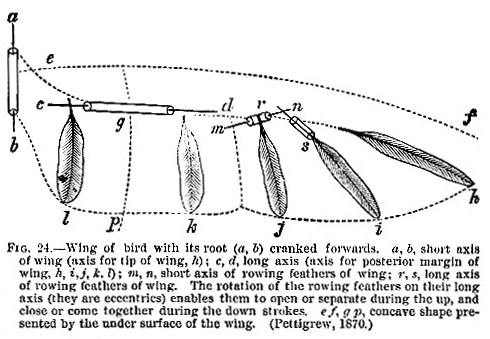
Not the least curious feature of the wing movements is the remarkable power which the wing possesses of making and utilizing its own currents. Thus, when the wing descends it draws after it a strong current, which, being met by the wing during its ascent, greatly increases the efficacy of the up stroke. Similarly and conversely when the wing ascends, it creates an upward current, which, being met by the wing when it descends, powerfully contributes to the efficiency of the down stroke. This statement can be readily verified by experiment both with natural and artificial wings. Neither the up nor the down strokes are complete in themselves.
The wing to act efficiently must be driven at a certain speed, and in such a manner that the down and up strokes shall glide into each other. It is only in this way that the air can be made to pulsate, and that the rhythm of the wing and the air waves can be made to correspond. The air must be seized and let go in a certain order and at a certain speed to extract a maximum recoil. The rapidity of the wing movements is regulated by the size of the wing, small wings being drive at a very much higher speed than larger ones. The different parts of the wing, moreover, are made to travel at different degrees of velocity-the tip and posterior margin of the wing always rushing through a much greater space, in a given time, than the root and anterior margin.
The rapidity of travel of the insect wing is in some cases enormous. The wasp, for instance, is said to ply its wings at the rate of 110, and the common house fly at the rate of 330 beats per second. Quick as are the vibrations of natural wings, the speed of certain parts of the wing is amazing increased. Wings as a rule are long and narrow. As a consequence, a comparatively slow and very limited movement at the root confers great range and immense speed at the tip, the speed of each portion of the wing increasing as the root of the wing is receded from. This is explained on a principle well understood in mechanics, viz., that when a wing or rod hinged at one end is made to move in a circle, the tip or free end of the wing or rod describes a much wider circle in a given time than a portion of the wing or rod nearer the hinge (fig. 25).
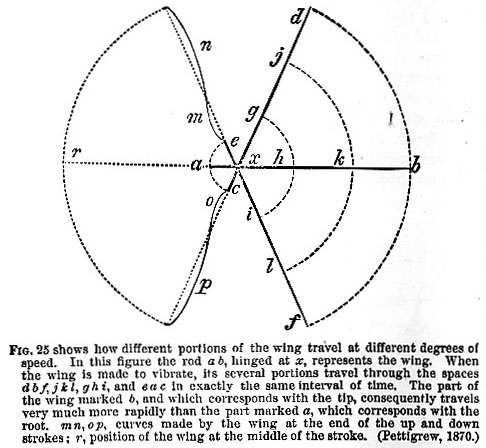
One naturally inquires why the high speed of wings, and why the progressive increase of speed at their tips and posterior margins. The answer is not far to seek. If the wings were not driven at a high speed, and if they were not eccentrics made to revolve upon two separate axes, they would of necessity be large cumbrous structures; but large heavy wings would be difficult to work, and what is worse they would (if too large) instead of controlling the air, be controlled by it, and so cease to be flying organs.
There is, however, another reason why wings should be a very vibrate at high speeds. The air, as explained, is a very light, thin, elastic medium, which yields on the slightest pressure, and unless the wings attacked it with great violence the necessary recoil or resistance could not be obtained. The atmosphere, because of its great tenuity, mobility, and comparative imponderability, presents little resistance to bodies passing through it at low velocities. If, however, the speed be greatly accelerated, the action of even an ordinary came is sufficient to elicit a recoil. This comes of the action and reaction of matter, the resistance experienced varying according to the density of the atmosphere and the shape, extent, and velocity of the body acting upon it. While, therefore, scarcely any impediment is offered to the progress of an animal in motion in the air, it is often exceedingly difficult to compress the air with sufficient rapidity and energy to convert it into a suitable fulcrum for securing the onward impetus. This arises from the fact that bodies moving in air experience a minimum of resistance and occasion a maximum of displacement. Another and very obvious difficulty is traceable to the great disparity in the weight of air as compared with any known solid, and the consequent want of buoying or sustaining power which that disparity involves. If we compare air with water we find it is nearly 1000 times lighter. To meet these peculiarities the insect, bat, and bird are furnished with extensive flying surfaces in the shape of wings, they apply with singular velocity and power to the air, as levers of the third order. In this form of lever, as the reader is aware, the power is applied between the fulcrum and the weight to be raised. The power is represented by the wing, the fulcrum by the air, and the weight by the body of the flying animal. Although the third order of lever is particularly inefficient when the fulcrum is rigid and immobile, it possesses singular advantages when these conditions are reversed, that is, when the fulcrum, as happens with the air, is elastic and yielding. In this instance a very slight movement at the root of the pinion, or that end of the lever directed towards the body, is followed by an immense sweep of the extremity of the wing, where its elevating and propelling power is greatest, - this arrangement ensuring that the large quantity of air necessary for propulsion and support shall be compressed under the most favorable conditions.
In this process the weight of the body performs an important part, by acting upon the inclined planes formed by the wings in the plane of progression. The power and the weight may thus be said to reciprocate, the two sitting as it were side by side and bending their peculiar influences to produce a common result, as indicated at fig. 26.
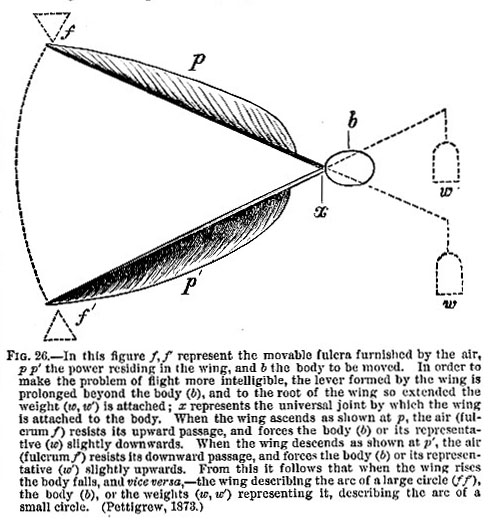
When the wings descend they elevate the body, the wings being active and the body passive; when the body descends it contributes to the elevation of the wings, the body being active and the wings passive. It is in this way that weight forms a factor in flight, the wings and the weight of the body reciprocating and mutually assisting and relieving each other. This is an argument for employing four wings in artificial flight, - the wings being so arranged that the two which are up shall always by their fall mechanically elevate the two which are down. Such an arrangement is calculated greatly to conserve the driving power, and, as a consequence, to reduce the weight.
That the weight of the body plays an important part in the production of flight may be proved by a very simple experiment. If two quill feathers are fixed in an ordinary cork, and so arranged that they expand and arch above it, it is found that if the apparatus be dropped from a vertical height of three yards it does not fall vertically downwards, but downwards and forwards in a curve, the forward travel amounting in some instances to a yard and a half. Here the cork, in falling, acts upon the feathers (which are to all intents and purposes wings), and these in turn act upon the air, in such a manner as to produce a horizontal transference. The apparatus which formed the subject of the present experiment is represented at fig. 27.
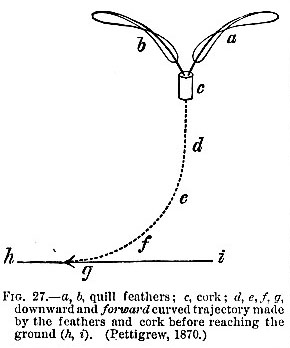
In order to utilize the air as a means of transit, the body in motion, whether it moves in virtue of the life it possesses, or because of a force superadded, must be heavier than air. It must tread and rise upon the air as a swimmer upon the water, or as a kite upon the wind. This is necessary for the simple reason that the body must be active, the air passive. The flying body must act against gravitation, and elevate and carry itself forward at the expense of the air and of the force which resides in it, whatever that may be. If it were otherwise – if it were rescued from the law of gravitation on the one hand, and bereft of independent movement on the other, it would float about uncontrolled and uncontrollable like an ordinary balloon.
In flight one of two things is necessary. Either the wings must attack the air with great violence, or the air in rapid motion must attack the wings; either suffices. If a bird attempts to fly in a clam, the wings must be made to smite the air after the manner of a boy’s kite with great vigor and at a high speed. In this case the wings fly the bird. If, however, the bird is fairly launched in space and a stiff breeze is blowing, all that is required in many instances is to extend the wings at a slight upward angle to the horizon so that the under parts of the wings present kite-like surfaces. Under these circumstances the rapidly moving air flies the bird. The flight of the albatross supplies the necessary illustration. If by any chance this magnificent bird alights upon the sea he must flap and beat the water and air with his wings with tremendous energy until he gets fairly launched. This done he extends his enormous pinions and sails majestically along, seldom deigning to flap his wings, the breeze doing the work for him. A familiar illustration of the same principle may be witnessed any day when children are engaged in their favorite pastime of kite-flying. If two boys attempt to fly a kite in a calm, the one must hold up the kite and let go when the other runs. In this case the under surface of the kite is made to strike the still air. If, however, a stiff autumn breeze be blowing, it suffices if the boy who formerly ran when the kite was let go stands still. In this case the air in rapid motion strikes the under surface of the kite and forces it up. The string and the hand are to the kite what the weight of the flying creature is to the inclined planes formed by its wings.
The area of the insect, bird, and bat, when the wings are fully expanded, is greater than that of any other class of animals, their weight being proportionally less. As already stated, however, it ought never to be forgotten that even the lightest insect, bird, or bat is vastly heavier than the air, and than no fixed relation exists between the weight of body and expanse of wing in any of the orders. We have thus light-bodied and large-winged insects and birds, as the butterfly and heron; and others with heavy bodies and small wings, as the beetle and partridge. Similar remarks are to be made of bats. Those apparent inconsistencies in the dimensions of the body and wings are readily explained by the greater muscular development of the heavy-bodied, small-winged insects, birds, and bats, and the increased power and rapidity with which the wings in them are made to oscillate. This is of the utmost importance in the science of aerostation, as showing that flight may be attained by a heavy powerful animal with comparatively small wings, as well as by a lighter one with greatly enlarged wings. While, therefore, there is apparently no correspondence between the area of the wing and the animal to be raised, there is, unless in the case of sailing insects, birds, and bats, an unvarying relation as to the weight and number of oscillations; so that the problem of flight would seem to resolve itself into one of weight, power, velocity, and small surfaces, versus buoyancy, debility, diminished speed, and extensive surfaces, - weight in either case being a sine qua non.
That no fixed relation exists between the area of the wings and the size and weight of the body is evident on comparing the dimensions of the wings and bodies of the several orders of insects, bats, and birds. If such comparison be made, it will be found that the pinions in some instances diminish while the bodies increase, and the converse. No practical good can therefore accrue to aerostation from elaborate measurements of the wings and body of any flying thing; neither can any rule be laid down as to the extent of surface required for sustaining a given weight in the air. The statements here advanced are borne out by the fact that the wings of insects, bats, and birds may be materially reduced without impairing their powers of flight. In such cases the speed with which the wings are driven is increased in the direct ratio of the mutilation. The inference to be deduced from the foregoing is plainly this, that even in large-bodied, small-winged insects and birds the wing-surface is greatly in excess, the surplus wing area supplying that degree of elevation and sustaining power which is necessary to prevent undue exertion on the part of the Volant animal. In this we have a partial explanation of the buoyancy of insects, and the great lifting power possessed by bats and birds, - the bats carrying their young without inconvenience, the birds elevating surprising of fish, game, carrion, & c. (fig. 28).
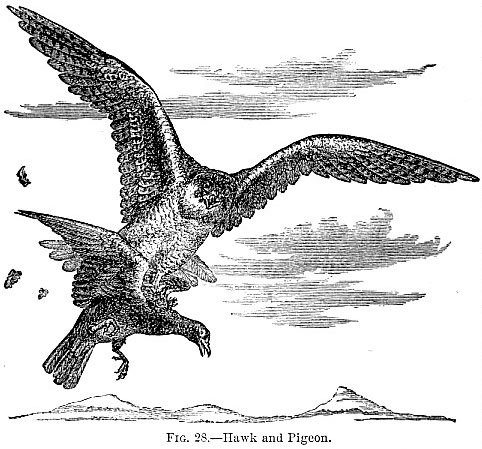
While, as explained, no definite relation exist between the weight of a flying animal and the size of its flying surface, there being, as stated, heavy-bodied and small-winged insects, bats, and birds, and the converse, and while, as has been shown, flight is possible within a wide range, the wing being, as a rule, in excess of what are required for the purpose of flight, - still it appears from the researches of M. de Lucy that there is a general law, to the effect that the larger the Volant animal the smaller by comparison are its flying surfaces. The existence of such a law is very encouraging so far as artificial flight is concerned, for it shows that the flying surfaces of a large, heavy, powerful flying machine will be comparatively small, and consequently comparatively compact and strong. This is a point of very considerable importance, as the object desiderated in a flying machine is elevating capacity.
M. de Lucy has tabulated his results as under: -
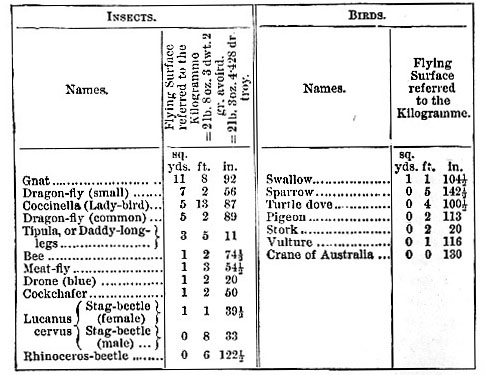
"It is easy, by the aid of this table, to follow the order, always decreasing, of the surfaces, in proportion as the winged animals increases in size and weight. Thus, in comparing the insects with one another, we find that the gnat, which weight 460 times less than the stag-beetle, has 14 times more of surface. The lady-bird weighs 150 times less than the same with the birds. The sparrow weighs about 10 times less than the pigeon, and has twice as much surface. The pigeon weighs about 8 times less than the stork, and has twice as much surface. The sparrow weights 339 times less than the Australian crane, and possesses 7 times more surface, &c. If now we compare the insects and the birds, the gradation will become even much more striking. The gnat, for example, weights 97,000 times less than the pigeon, and has 40 times more surface; it weights three millions of times less than the crane of Australia, and possesses 140 times more of surface than this latter, the weight of which is about 9 kilogrammes 500 grammes (25 lb 5 oz. 9 dwt. Troy, 20 lb 15 oz. 2 _ dr. avoirdupois).
The Australian crane, the heaviest bird weighted, is that which has the smallest amount of surface, for referred to the kilogramme, it does not give us a surface of more than 899 square centimeters (139 square inches), that is to say, about an eleventh part of a square meter. But every one knows that these grallatorial animals are excellent birds of flight. Of all traveling birds they undertake the longest and most remote journeys. They are, in addition, the eagle excepted, the birds which elevate themselves the highest, and the flight of which is the longest maintained."
The way in which the natural wing rises and falls on the air, and reciprocates with the body of the flying creature, has a very obvious bearing upon artificial flight. In natural flight the body of the flying creature falls slightly forward in a curve when the wing ascends, and is slightly elevated in a curve when the wing descends. The wing and body are consequently always playing at cross purposes, the wing rising when the body is falling and vice versa. The alternate rise and fall of the body and wing of the bird are well seen when contemplating the flight of the gull from the stern of a steamboat, as the bird is following in the wake of the vessel. The complementary movements referred to are indicated at fig. 29, where the continuous waved line represents the trajectory made by the wing, and the dotted waved line that made by the body. As will be seen from this figure, the wing advances both when it rises and when it falls. It is a condition of natural wings, and of artificial wings constructed on the principle of living wings, that when forcibly elevated or depressed, even in a strictly vertical direction, they inevitably dart forward. If, for instance, the wing is suddenly depressed in a vertical direction, as at a b of fig. 29, it at once darts downwards and forwards (see continuous line of figure) to c, thus converting the vertical down stroke into a down, oblique, forward stroke. If, again, the wing be suddenly elevated in a strictly vertical direction, as at c d, the wing as certainly darts upwards and forwards in a curve, to e, thus converting the vertical up strokes into an upward, oblique, forward stroke. The same thing happens when the wing is depressed from e to f and elevated from g to h, the wing describing a waved track as at e g, g i.

There are good reasons why the wings should always be in advanced of the body. A bird when flying is a body in motion; but a body in motion tends to fall not vertically downwards, but downwards and forwards. The wings consequently must be in advanced of the body of the bird if they are to prevent the bird from falling downwards and forwards. If the wings were to strike backwards in aerial flight, the bird would turn a forward somersault.
That the wings invariably strike downwards and forwards in aerial flight is proved alike by observation and experiment. If any one watches a bird rising from the ground or the water, he cannot fail to perceive that the head and body are slightly titled upwards, and that the wings are made to descent with great vigor in a downward and forward direction. The dead natural wing and a properly constructed artificial wing act in precisely the same way. If the wing of a gannet, just shot, be removed and made to flap in what the operator believes to be a strictly vertical downward direction, the tip of the wing, in spite of him, will dart forwards between two and three feet – the amount of forward movement being regulated by the rapidity of the down stroke. This is a very striking experiment. The same thing happens with a properly constructed artificial wing. The down stroke with the artificial as with the natural wing is invariably converted into an oblique, downward, and forward stroke. No one ever saw a bird in the air flapping its wings towards its tail. The old idea was that the wings pushed the body of the bird in an upward and forward direction; in reality the wings do not push but pull, and in order to pull they must always be in advance of the body to be flown. If the wings did not themselves fly forward, they could not possibly cause the body of the bird to fly forward. It is the wings which fly the bird, and not the converse.
It only remains to be stated that the wing acts as a true kite, during both down and up strokes, its under concave or biting surface, in virtue of the forward travel communicated to it by the body of the flying creature, being closely applied to the air, during both its ascent and its descent. This explains how the wing furnishes a persistent buoyancy alike when it rises and when it falls (fig. 30).
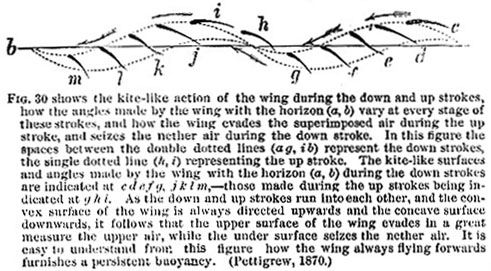
The natural kite formed by the wing differs from the artificial kite only in this, that the former is capable of being moved in all its parts, and is more or less flexible and elastic, whereas the latter is comparatively rigid. The flexibility and elasticity of the kite formed by the natural wing are rendered necessary by the fact that the wing, as already stated, is practically hinged at its root and along its anterior margin, an arrangement which necessitates its several parts traveling at different degrees of speed, in proportion as they are removed from the axes of rotation. Thus the tip travels at a higher speed than the root, and the posterior margin than the anterior margin. This begets a twisting diagonal movement of the wing on its long axis, which, but for the elasticity referred to, would break the wing into fragments. The elasticity contributes also to the continuous play of the wing, and insures that no two parts of it shall reverse at exactly the same instant. If the wing was in elastic, every part of it would reverse are precisely the same moment, and its vibration would be characterized by pauses or dead points at the end of the down and up strokes which would be fatal to it as a flying organ. The elastic properties of the wing are absolutely essential, when the mechanism and movements of the pinion are taken into account. A rigid wing can never be an effective flying instrument.
The kite-like surfaces referred to in natural flight are those upon which the constructors of flying machines very properly ground their hopes of ultimate success. These surfaces may be conferred on artificial wings, aeroplanes, aerial screws, or similar structures; and these structures, if we may judge from what we find in nature, should be of moderate size and elastic. The power of the flying organs will be increased if they are driven at a comparatively high speed, and particularly if they are made to reverse and reciprocate, as in this case they will practically create the currents upon which they are destined to rise and advance. The angles made by the kite-like surfaces with the horizon should vary according to circumstances. They should be small when the speed is high, and vice versa. This, as stated, is true of natural wings. It should also be true of artificial wings and their analogues. There is no escaping from natural laws. A knowledge of natural laws alone will enable us to construct (it is to be hoped in the immediate future) the much-desired flying machine.
Having explained as far as space would permit how water differs from air, how the sailing ship differs from the balloon, and how the balloon differs from the flying creature and flying machine constructed on the living type, and having further explained the peculiarities of wings and wing movements as witnessed in natural flight, we are now in a position to enter upon a consideration of artificial wings and wing movements, and of artificial flight and flying machines.
We begin with artificial wings. The first properly authenticated account of an artificial wing was given by Borelli in 1670. This author, distinguished alike as a physiologist, mathematician, and mechanician, describes and figures a bird with artificial wings, each of which consists of a rigid rod in front and flexible feathers behind. The wings are represented as striking vertically downwards, as the annexed duplicate of Borelli’s figure shows (fig. 31.)
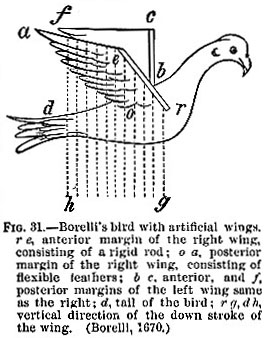
Borelli was of opinion that flight resulted from the application of an inclined plane, which beats the air, and which has a wedge action. He, in fact, endeavor to prove that a bird wedges itself forward upon the air by the perpendicular vibration of its wings, the wings during their action forming a wedge, the base of which (c b e ) is directed towards the head of the bird, the apex (a f ) being directed towards the tail (d). In the 196th proposition of his work (De motu Animalium, Leyden, 1685) he states that –
"If the expanded wings of a bird suspended in the air shall strike the undisturbed air beneath it with a motion perpendicular to the horizonb, the bird will fly with a transverse motion in a plane parallel with the horizon." "If," he adds, "the wings of the bird be expanded, and the under surface of the wings be struck by the air ascending perpendicularly to the horizon with such a force as shall prevent the bird gliding downward (i.e. with a tendency to glide downwards) from falling, it will be urged in a horizontal direction."
The same argument is re-stated in different words as under: - "If the air under the wings be struck by the flexible portions of the wings (flabella, literally fly flaps or small fans) with a motion perpendicular to the horizon, the sails (vela) and flexible portions of the wings (flabella) will yield in an upward direction and form a wedge, the point of which is directed towards the tail. Whether, therefore, the air strikes the wings from below, or the wings strike the air from above, the result is the same, - the posterior or flexible margins of the wings yield in an upward direction, and in so doing urge the bird in a horizontal direction."
There are three points in Borelli’s argument to which it is necessary to draw attention: (1) the direction of the down stroke: it is stated to be vertically downwards: (2) the construction of the anterior margin of the wing: it is stated to consist of a rigid rod; (3) the function delegated to the posterior margin of the wing: it is said to yield in an upward direction during the down stroke.
With regard to the first point. It is incorrect to say the wing strikes vertically downwards, for, as already explained, the body of a flying bird is a body in motion; but as a body in motion tends to fall downwards and forwards, the wing must strike downwards and forwards in order effectually to prevent its fall. Moreover, in point of fact, all natural wings and all artificial wings constructed on the natural type invariably strike downwards and forwards.
With regard to the second point, viz., the supposed rigidity of the anterior margin of the wing, it is only necessary to examine the anterior margins of natural wings to be convinced that they are in every case flexible and elastic. Similar remarks apply to properly constructed artificial wings. If the anterior margins of natural and artificial wings were rigid, it would be impossible to make them vibrate smoothly and continuously. This is a matter of experiment. If a rigid rod, or a wing with a rigid anterior margin, be made to vibrate, the vibration is characterized by an unequal jerky motion, which contrast strangely with the smooth, steady, fanning movement peculiar to natural wings.
As to the third point, viz., the upward bending of the posterior margin of the wing during the down stroke, it is necessary to remark that the statement is true if it means a slight upward bending, but that it is untrue if it means an extensive upward bending.
Borelli does not state the amount of upward bending, but one of his followes, Professor E.J. Marey, maintains that during the down stroke the wing yields until its under surface makes a backward angle with the horizon of 45°. Marey further states that during the up stroke the wing yields to a corresponding extent in an opposite direction – the posterior margin of the wing, according to him, passing through an angle of 90°, plus or minus, according to circumstances, every time the wing rises and falls.
That the posterior margin of the wing yields to a slight extent during both the down and up strokes will readily be admitted, alike because of the very delicate and highly elastic properties of the posterior margins of wings, and because of the comparatively great force employed in their propulsion; but that they do not yield to the extent stated by Professor Marey is a matter of absolute certainty. This admits of direct proof. If any one watches the horizontal or upward flight of a large he will observe that the posterior or flexible margin of the wing never rises during the down stroke to a perceptible extent, so that the under surface of the wing never looks backwards. On the contrary, be will perceive that the under surface of the wing (during the down stroke) invariably looks forwards and forms a true kite with the horizon, the angles made by the kite varying at every part of the down stroke, as shown more particularly at e d e f g, I j k l m of fig. 30, p. 317.
The authors who have adopted Borelli’s plan of artificial wing, and who have endorsed his mechanical views of the wing’s action most fully, are Chabrier, Straus-Durkheim, Girard, and Marey. Borelli’s artificial wing, it will be remembered, consists of a rigid rod in front and a flexible sail behind. It is also made to strike vertically downwards. According to Chabrier, the wing has only one period of activity. He believes that if the wing be suddenly lowered by the depressor muscles, it is elevated solely by the reaction of the air. There is one unanswerable objection to this theory: the bats and birds, and some if not all the insects, have distinct elevator muscles , and can elevate their wings at pleasure when not flying and when consequently the reaction of the air is not elicited. Straus-Durkheim agrees with Borelli both as to the natural and the artificial wing. Durkheim is of opinion that the insect abstracts from the air by means of the inclined plane a component force (composant) which it employs to support and direct itself. In his theology of nature he describes a schematic wing as consisting of a rigid ribbing in front, and a flexible sail behind. A membrane so constructed will, according to him, be fit for flight. It will suffice if such a sail elevates and lowers itself successively. It will of its own accord dispose itself as an inclined plane, and receiving obliquely the reaction of the air, it transfers into tractile force a part of the vertical impulsion it has received. These two parts of the wing, moreover, are equally indispensable to each other.
Marey repeats Borelli and Durckheim with very trifling modifications, so late as 1869. He describes two artificial wings, the one composed of a rigid rod and sail-the rod representing the stiff anterior margin of the wing; the sail which is made of paper bordered with card board, the flexible posterior margin. The other wing consists of a rigid nervure in front and behind of thin parchment which supports fine rods of steel. He states that, if the wing only elevates and depresses itself, "the resistance of the air is sufficient to produce all the other movements. In effect (according to Marey) the wing of an insect has not the power of equal resistance in every part. On the anterior margin the extended nervures make it rigid, while behind it is fine and flexible. During the vigorous depression of the wing, the nervure has the power of remaining rigid, whereas the flexible portion, being pushed in an upward direction on account of the resistance it experiences from the air, assume an oblique position which causes the upper surface of the wing to look forwards." The reverse of this, in Marey’s opinion,, takes place during the elevation of the wing-the resistance of the air from above causing the upper surface of the wing to look backwards. …….. "At first,: he says, "the plane of the wing is parallel with body of the animal. It lowers itself-the front part of the wing strongly resists, the sail which follows it being flexible yields. Carried by the ribbing (the anterior margin of the wing) which lowers itself, the sail or posterior margin of the wing being raised meanwhile by the air, which sets it straight again, in the sail will take an intermediate position and incline itself about 45° plus or minus according to circumstances…….The wing continues its movements of depression inclined to the horizon; but the impulse of the air, which continues its effect, and naturally acts upon the surface which it strikes, has the power of resolving itself into two forces, a vertical and a horizontal force; the first suffices to raise the animal, the second to move it along." Professor Marey, it will be observed, reproduces Borelli’s artificial wing, and even his text, at a distance of nearly two centuries.
The artificial wing recommended by Professor Pettigrew is a more exact imitation of nature than either of the foregoing. It is of a more or less triangular form, thick at the root and anterior margin, and thin at the tip and posterior margin. No part of it is rigid. It is on the contrary highly elastic and flexible throughout. It is furnished with springs at its root to contribute to its continued play, and is applied to the air by a direct piston action in such a way that it descends in a downward and forward direction during the down stroke, and ascends in an upward and forward direction during the up stroke. It elevates and propels both when it rises and falls. It, moreover, twists and untwists during its action and describes figure-of-8 and waved tracks in space, precisely as the natural wing does. The twisting is most marked at the tip and posterior margin, particularly that half of the posterior margin next the tip. The wing when in action may be divided into two portions by a line running diagonally between the tip of the wing anteriorly and the root of the wing posteriorly. The tip and posterior parts of the wing are more active than the root and anterior parts, from the fact that the tip and posterior parts (the wing is an eccentric) always travel through greater spaces. In a given time, than the root and anterior parts.
The wings is so constructed that the posterior margin yields freely in a downward direction during the up stroke, while it yields comparatively little in an upward direction during the down stroke; and this is a distinguishing feature, as the wing is thus made to fold and elude the air more or less completely during the up stroke, whereas it is made to expand and seize the air with avidity during the down stroke. The oblique line referred to as running diagonally across the wing virtually divides the wing into an active and a passive part, the former elevating and propelling, the latter sustaining.
It is not possible to determine with exactitude the precise function discharged by each part of the wing, but experiment tend to show that the tip of the wing elevates, the posterior margin propels, and the root sustains.
The wing-and this is important- is driven by a direct piston action with an irregular hammer-like movement, the pinion having communicated to it a smart click at the beginning of every down stroke-the up stroke being more uniform. The following is the arrangement (fig. 32). If the artificial wing here represented (fig. 32) be compared with the natural wing as depicted at fig. 33, it will be seen that there is nothing in the one which is not virtually reproduced in the other. In addition to the foregoing, Professor Pettigrew recommends a double elastic wing to be applied to the air like a steam-hammer, by being fixed to the head of the piston. This wing, like the single wing described, twists and untwists as it rises and falls, and possesses all the characteristics of the natural wing (fig 34).
He also recommends an elastic aerial screw consisting of two blades, which taper and become thinner towards the tips and posterior margin. When the screw is made to rotate, the blades, because of their elasticity, assume a great variety of angles, the angles being least where the speed of the blades is greatest and vice versa. The pitch of the blades is thus regulated by the speed attained (fig. 35).
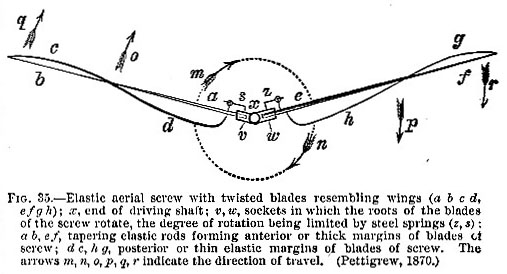
The peculiarity of Professor Pettigrew’s wing and screws consists in their elasticity, their twisting action, and their great comparative length and narrowness. They offer little resistance to the air when they are at rest, and when in motion the speed with which they are driven is such as to ensure that the comparatively large spaces through which they travel shall practically be converted into solid bases of support.
Since Professor Pettigrew enunciated his views (1867) as to the screw configuration and elastic properties of natural wings, and more especially since his introduction of spiral, elastic artificial wings, and elastic screws, a great revolution has taken place in the construction of flying models. Elastic aero-planes are now advocated by Mr Brown, elastic aerial screws by Mr Armour, and elastic aero-planes, wings, and screws by Mr. Penaud.
M. Penaud’s experiments are alike interesting and instructive. He constructed models to fly by three different methods: (a) by means of screws acting vertically upwards; (b) by aero-planes propelled horizontally by screws; and (c) by wings which flapped in an upward and downward direction. An account of his helicopter or screw model appears in the Aeronaut for January 1872, but before giving a description of it, it may be well to state very briefly what is known regarding the history of the screw as applied to the air.
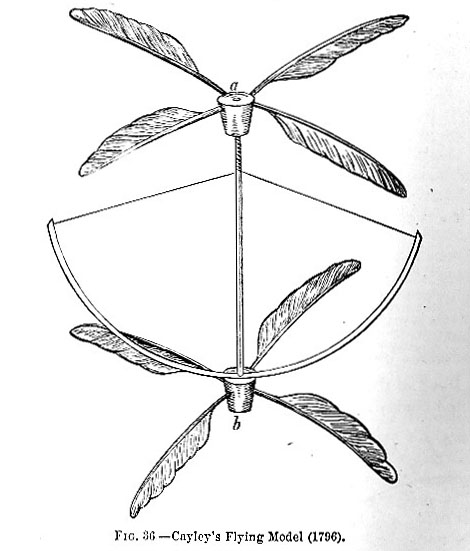
The first suggestion on this subject was given by Paucton in 1768. This author, in his treatise on the Theorie de la Vis d’Archimee, describes a machine provided with two screws which he calls a "pterophores." In 1796 Sir George Cayley gave a practical illustration of the efficacy of the screw as applied to the air by constructing a small machine, consisting of two screws made of will feathers, a representation of which we annex (fig. 36). Sir George writes as under:-
"As it may be an amusement to some of your readers to see a machine rise in the air by mechanical means, I will conclude my present communication by describing an instrument of this kind, which any one can construct at the expense of ten minutes’ labour.
"a and b, 36, are two corks, into each of which are inserted four wing feathers from any bird, so as to slightly inclined like the sails of a windmill, but in opposite directions in each set. A round shaft is fixed in the cork a, which ends in a sharp point. At the upper part of the cork b is fixed a whalebone bow, having a small pivot hole in its center to receive the point of the shaft. The bow is the to be strung equally on each side to the upper portion of the shaft, and the little machine is completed. Wind up the string by turning the flyers different ways, so that the spring of the bow may unwind them with their anterior edges ascending; then place the cork with the bow attached to it upon a table and with a finger on the upper cork press strong enough to prevent the string from unwinding, and taking it away suddenly, the instrument will rise to the ceiling."
Cayley’s screws were peculiar, inasmuch as they were superimposed and rotated in opposite directions. He estimated that if the area of the screws was increased to 200 square feet, and moved by a man, they would elevate him. His interesting experiment is described at length, and the apparatus figured, in Nicolson’s Journal, 1809, p. 172.
Other experimenters followed Cayley at moderate intervals: - Deghen in 1816, Ottoris Sarti in 1823, and Dubochet in 1834. These inventors all constructed flying models on the vertical screw principle. In 1842 Mr Philips succeeded in elevating a steam model by the aid of revolving fans, which flew across two fields after having attained a great altitude; and in 1859 Mr Bright took out a patent for a machine to be sustained by vertical screws, the model of which is to be seen at the patent museum, Kensington, London. In 1863 the subject of aviation by vertical screws received a fresh impulse from the experiments of MM. Ponton d’Amecourt. De la Landelle, and Nadar, who exhibited models driven by clock-work springs, which ascended with graduated weights a distance of from 10 to 12 feet. These models were so fragile that they usually broke in coming in contact with the ground in their descent. Their flight, moreover, was unsatisfactory, from the fact that it only lasted a few seconds.
Stimulated by the success of his spring models, M. Ponton d’Amecourt had a small steam model constructed. This model, which was shown at the exhibition of the Aeronautical Society of Great Britain at the Crystal Palace in 1868, consisted of two superposed screws propelled by an engine, the steam for which was generated (for lightness) in an aluminium boiler. This steam model proved a failure, inasmuch as it only lifted a third of its own weight.
Fig. 37 embodies M. de la Landelle’s ideas.
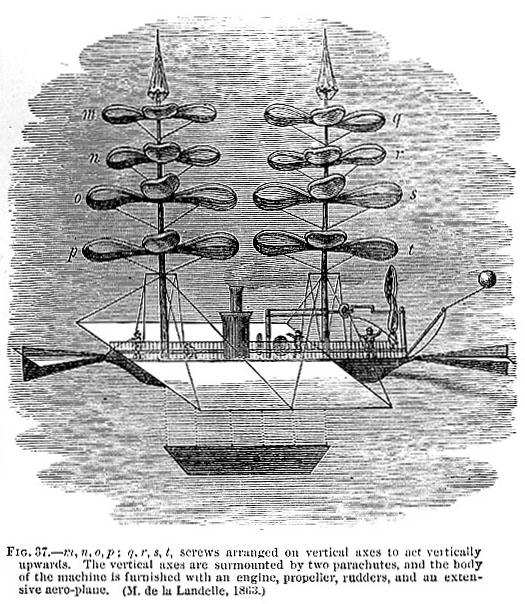
All the models referred to (Cayley’s excepted) were provided with rigid screws, which, for many reasons, we are disposed to regard as an error. In 1872 M. Penaud discarded the rigid screws in favor of elastic ones, as Professor Pettigrew has done some years before.
M. Penaud also substituted India-rubber under torsion for the whalebone and clock springs of the smaller models, and the steam of the larger ones. His helicopter or screw model is remarkable for its lightness, simplicity, and power. The accompanying sketch will serve to illustrate its construction (fig. 38). It consists of two superposed elastic screws (a a, b b), the upper of which (a a) is fixed in a vertical frame (c), which is pivoted in the central part (d) of the under screw. From the center of the under screw an exle provided with a hook (e), which performs the part of a crank, projects in an upward direction. Between the hook or crank (e) and the center of the upper screw (a a), the India-rubber in a state of torsion(f) extends. By fixing the lower screw and turning the upper one a sufficient number of times the requisite degree of torsion and power is obtained. The apparatus when liberated flies into the air sometimes to a height of 50 feet, and gyrates in beautiful large circles for a period varying from 15 to 30 seconds.
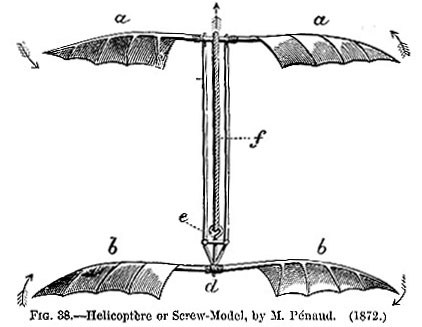
M. Penaud next directed his attention to the construction of a model, to be propelled by a screw and sustained by an elastic aero-plane extending horizontally. Sir George Cayley, it should be stated, proposed such a machine in 1810, and Mr Henson (as will be shown subsequently) constructed and patented a similar machine in 1842.
Several other inventors succeeded in making models fly by the aid of aero-planes and screws, as e.g., Mr Stringfellow in 1847, M. du Temple in 1857, and M. Jullien in 1858. As rigid aero-planes and screws were employed in the construction of these models they flew in a hap-hazard sort of a way, it being found exceedingly difficult to confer on them the necessary degree of stability fore and aft and laterally. M. Penaud succeeded in overcoming the difficulty in question by the invention of what he designates his automatic rudder. This consists of a small elastic aero-plane placed aft or behind the principal aero-plane which is also elastic. The two elastic aero-planes extend horizontally and make a slight upward angle with the horizon, the angle made by the smaller aero-plane (the rudder) being slightly in excess of that made by the larger. The motive power is India-rubber in the condition of torsion; the propellor, a screw. The reader will understand the arrangement by a reference to the accompanying drawing (fig. 39).
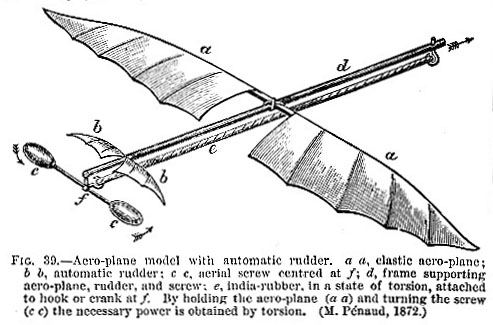
Models on the aero-plane screw type may be propelled by two screws, one force and one aft, rotating in opposite directions; and in the event of only one screw being employed it may be placed in front of or behind the aero-plane.
When the model is would up and let go it descends about two feet, after which, having acquired initial velocity, it rises and flies in a forward direction at a height of from 8 to 10 feet form the ground for a distance of from 120 to 130 feet. It flies this distance in from 10 to 11 seconds, its mean speed being something like 12 feet per second. From experiments made with this model, M. Penaud calculates that one horse power would elevate and support 85 lb.
Mr. Brown has also written (1874) in support of elastic aero-bi-planes. His experiments prove that two elastic aero-planes untie by a central or shafts, and separated by a wide interval, always produce increased stability. The production of flight by the vertical flapping of wings is in some respects the most difficult, but this also has been attempted and achieved. M. Penaud and M, de Villeneuve have each constructed winged models. Professor Marey was not so fortunate. He endeavored to construct an artificial insect on the plan advocated by Borelli, Straus-Durckheim, and Chabrier, but signally failed, his insect never having been able to lift more than a third of its own weight.
MM. de Villeneuve and Penaud constructed their winged models on different types, the former selecting the bat, the latter the bird. B. Villeneuve made the wings of his artificial bat conical in shape and comparatively rigid. He controlled the movements of the wings, and made them strike downwards and forwards in imitation of natural wings, as described by Professor Pettigrew. His model possessed great power of rising. It elevated itself from the ground with ease, and flew in a horizontal direction for a distance of 24 feet, and at a velocity of 20 miles an hour. M. Penaud’s model differed from M. de Villeneuve’s in being provided with elastic wings, the posterior margins of which in addition to being elastic were free to move round the anterior margins as round axes (see p. 313, fig. 24). India-rubber springs were made to extend between the inner posterior parts of the wings and the frame, corresponding to the backbone of the bird.
A vertical movement having been communicated by means of India-rubber in a state of torsion to the roots of the wings, the wings themselves, in virtue of their elasticity, and because of the resistance experienced from the air, twisted and untwisted and formed reciprocating screws, precisely analogous to those originally described and figures by Professor Pettigrew in 1867. M. Penaud’s arrangement is shown in fig.40.
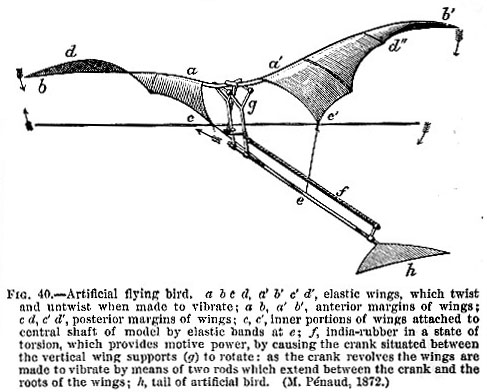
If the left wing M. Penaud’s model (a b, c d of fig. 40) be compared with the of the bat as drawn by Professor Pettigrew (fig. 18, page 313), or with Professor Pettigrew’s artificial wing (page 319, fig. 32), the identity of principle and application is at once apparent.
The twisting kite-like action of the wings, to which allusion has so frequently been made, and to which, as has been shown, Professor Pettigrew first strongly directed attention in 1867, justifies our introductory remarks as to the very intimate relation which subsists between natural and artificial flight. As already stated, it is not possible to understand artificial flight in the absence of a knowledge of natural flight.
In M. Penaud’s artificial bird the equilibrium is secured by the addition of a tail. The model cannot raise itself from the ground, but on being liberated from the hand it descends 2 feet or so, when, having acquired initial velocity, it flies horizontally for a distance of 50 or more feet, and rises as it flies from 7 to 9 feet. The following are the measurements of the model in question: - length of wing from tip to tip, 32 inches; weight of wing, tail, frame, India-rubber, &c., 73 grammes (about 2 1/2 ounces).
We have referred to Mr Henson’s flying machine, which was designed in 1843. As it was the earliest attempt at aerostation on a great scale it deserves a more than passing notice. Mr Henson was one of the first to combine aerial screws with extensive supporting structures occupying a nearly horizontal position. The accompanying illustration explains the combination (fig. 41).
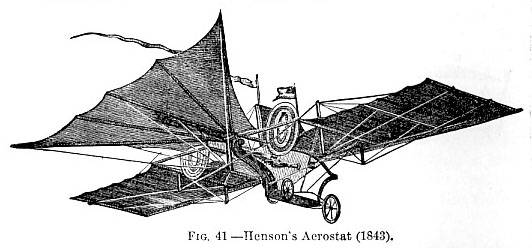
"The chief feature of the invention was the very great expanse of its sustaining planes, which were larger in proportion to the weight it had to carry than those of many birds. The machine advanced with its front edge a little raised, the effect of which was to present its under surface to the air over which, acting upon it like a strong wind on the sails of a windmill, prevented the descent of the machine and its burden. The sustaining of the whole, therefore, depended upon the speed at which it traveled through the air, and the angle at which its under surface impinged on the air in its front…. The machine, fully prepared for flight, was started from the top of an inclined plane, in descending which it attained a velocity necessary to sustain it in its further progress. That velocity would be gradually destroyed by the resistance of the air to the forward flight; it was, therefore, the office of the steam-engine and the vanes it actuated simply to repair the loss of velocity; it was made, therefore only of the power and weight necessary for that small effect." The editor of Newton’s Journal of Arts and Sciences speaks of it thus: - "The apparatus consists of a car containing the goods, passengers, engines, fuel, &c. to which a rectangular frame, made of wood or bamboo cane, and covered with canvas or oiled silk, is attached. This frame extends on either side of the car in a similar manner to the outstretched wings of a bird; but with this difference, that the frame is immovable. Behind the wings are two vertical fan wheels, furnished with oblique vanes, which are intended to propel the apparatus through the air. The rainbow-like circular wheels are the propellers, answering to the wheels of a steam-boat, and acting upon the air after the manner of a windmill. These wheels receive motions from bands and pulleys from a steam or other engine contained in the car. To an axis at the stern of the car a triangular frame is attached, resembling the tail of a bird, which is also covered with canvas or oiled silk. This may be expanded or contracted at pleasure, and is moved up and down for the purpose of causing the machine to ascend or descend. Beneath the tail is a rudder for directing the course of the machine to the right or to the left; and to facilitate the steering a sail is stretched between two masts which rise from the car. The amount of canvas or oiled silk necessary for buoying up the machine is stated to be equal to one square foot for each half pound of weight."
The defect of Mr Henson’s machine consists mainly in its rigidity, and in the vast amount of sustaining surface displayed by it, this approximating it in some measure to the balloon.
Mr Wenham, thinking to improve upon Mr Henson, invented in 1867 what he designed his aero-planes. The aero-planes are thin, light, long, narrow structures, arranged above each other in tiers like so many shelves. They are tied together at a slight upward angle, and combine strength and lightness. The idea is to obtain great sustaining area in comparatively small space. It was hoped that when the aero-planes were wedged forward in the air by vertical screws, or by the body to be flown, each earo-plane would rest or float upon a stratum of undisturbed air, and that practically the aero-planes would give the same support as if spread out horizontally. The aero—planes may be said to form a compound kite, and have only been partially successful. They are rigid and present a large extent of dead surface, so that the same objections made to Mr Henson’s arrangement apply to them. The great sustaining surface they present forms at once their strength and weakness. They sustain and lift, but are very difficult to wedge forward, and if a breeze be blowing they become unmanageable, in the sense that a balloon is unmanageable. The accompanying figures illustrate Mr Wenham’s views (figs. 42 and 43).
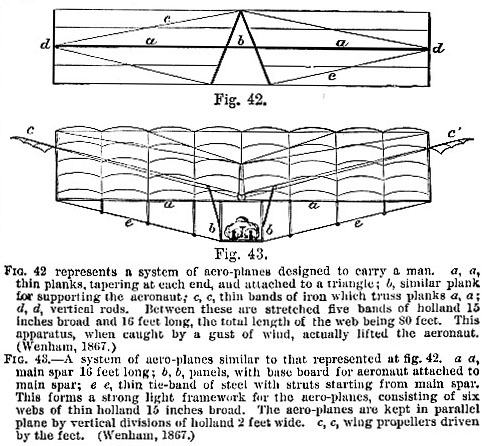
Mr Stringfellow, who was originally associated with Mr Henson, and constructed successful flying model in 1847, built a second model in 1868, in which Mr Wenham’s aero-planes were combined with aerial screws. This model was on view at the Exhibition of the Aeronautical Society of Great Britain, held at the Crystal Palace, London, in 1868. It was remarkably compact, elegant, and light, and obtained the 100 pounds prize of the exhibition for its engine, which was the lighted and most powerful ever constructed. The annexed woodcut (fig. 44), taken from a photograph of Mr Stringfellow’s model, gives a very good idea of the arrangement, - a b, c representing the superimposed planes, d the tail, e, f the vertical screw propellers. The superimposed planes (a b, c) in this machine contained a sustaining area of 28 square feet, in addition to the tail (d). Its engine represented a third of a horse power, and the weight of the whole (engine, boiler, water, fuel, superimposed planes, and propellers) was under 12 lb. Its sustaining area, if that of the tail (d) he included, was something like 36 square feet, i.e.g 3 square feet for every pound. The model was forced by its propellers along a wire at a great speed, but so far as an observer could determine, failed to lift itself, notwithstanding its extreme lightness and the comparatively very great power employed Mr Stringfellow stated that his machine occasionally left the wire and was sustained by its aero-planes alone. The horizontal speed attained was certainly very great; but as the machine was exhibited under cover in the Crystal palace buildings, and ran along a wire, it is doubtful how it would have deported itself in the open air. Everything about it was rigid, the aero-planes, screws, &c., and as the dead surfaces displayed were comparatively very large, the chances are that it would not have been able to hold its own against air currents. That the principle of its construction was faulty is proved beyond doubt by the fact that it weighed under 12 lb, while it engine exerted a third of a horse power. No flying creature, as is well-known, weighing 12 lb possesses a tithe of the power indicated. This fact is significant as showing that flight is not a mere question of levity and power. As has been more than once stated in the present article, the mystery of flight can only be cleared up by an intelligent study of the structure and mode of application of the flying organs of animals. It is to natural flight and the principles which underlie it that the aeronaut must look for a solution of the intensely interesting but vastly complicated problem of aerial navigation.
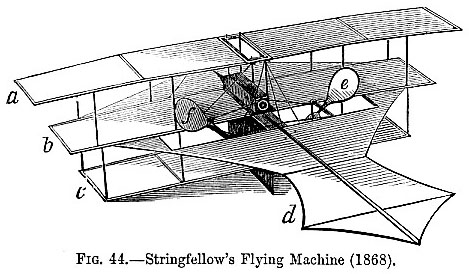
The idea embodied by Henson, Wenham, and Stringfellow is plainly that of a boy’s kite sailing upon the wind. The kite, however, is a more perfect flying apparatus than that furnished by these gentlemen, inasmuch as the inclined plane formed by its body strikes the air at various angles-the angles varying according to the length of string, strength of breeze, length and weight of tail, &c. Henson’s, Wenham’s, and Stringfellow’s methods, although carefully tried, have hitherto failed. The objections are numerous. In the first place, the supporting planes (aero planes or other forms) are not flexible and elastic as wings are, but rigid; 2d, they strike the air at a given angle, where, again, there is a departure from nature; 3d, a machine so constructed must be precipitated from a height or driven along the surface of the land or water at a high speed to supply it with initial velocity; 4th, it is unfitted for flying with the wind unless its speed greatly exceeds that of the wind; 5th, it is unfitted for flying across the winf because of the large surfaces exposed; 6th, the sustaining surfaces are passive or dead surfaces, i.e. they have no power of moving or accommodating themselves to altered circumstances. Natural wings, as explained, present small flying surfaces, and these can be applied to the air at any degree of obliquity-the great speed at which wings are propelled converting the spaces through which they pass into what are practically solid bases of support, as indicated at pp. 310, 313 (figs. 9, 20, 21, 22, and 23).
This arrangement enables natural wings to seize and utilize the air, and renders them superior to adventitious currents. Natural wings work up the air in which they move; but unless the Volant animal desires it, they are scarcely, if at all, influenced by winds or currents which are not of their own forming. In this respect they differ entirely from the balloon and all forms of fixed aero-planes. In nature small wings driven at a high speed produce the same result as large wings driven at a low speed. In flight a certain space must be covered, either by large wings spread out as solids, or by small wings made to vibrate rapidly. A like result is obtained if air current traveling at a high speed strike the under surfaces of the wings of the Volant animal. In the former cases the wings are active, the air passive; in the latter case the air is active and the wing passive.
It would be easy to multiply almost indefinitely our list of aerial models and flying machines. As however the present article has already attained sufficiently large dimensions it will suffice if we refer in conclusion to the aerial steamer of Mr Moy, designated in 1874, and still in process of construction. Its leading features will readily be understood by a reference to the annexed drawing (fig. 45). Mr Moy’s invention consists of a light, powerful, skeleton frame resting on three wheels; a very effective light engine constructed on a new principle, which dispenses with the old-fashioned, cumbrous boiler; two long, narrow, horizontal aero-planes; and two comparatively very large aerial screws. The idea is to get up the initial velocity by a preliminary run on the ground. This accomplished it is hoped that the weight of the machine will gradually be thrown upon the aero-planes in the same way that the weight of certain birds-the eagle, e.g.-is thrown upon the wings after a few hops and leaps. Once in the air the aero-planes will become effective in proportion to the speed attained. Mr Moy’s machine resembles in its general features that of Mr Stringfellow. It repeats its defects as far as rigid surfaces are concerned, but it has the advantage in presenting a relativelyless amount of surface. The diminished surface of Mr Moy’s machine is, moreover, more broken up, and what is important, a relatively greater proportion of the surface (so diminished and broken up) is made active or moving surface. These are hopeful features.
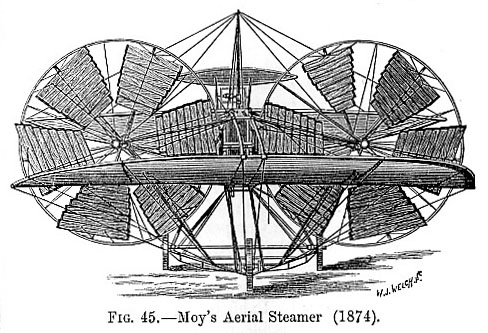
The unremitting efforts of Mr Moy and other British engineers to construct flying machines deserve well of science. They are significant as showing that the great subject of aerial navigation is at length receiving a fair share of the thought and energy of a country which has already produced the locomotive engine, and which, there is good reason to believe, is destined also to produce the flying machine. (J. B. P.)
The above article was written by James Bell Pettigrew, M.D., LL.D., F.R.C.P., F. R.S.; Chandos Professor of Medicine and Anatomy, St. Andrews Univ., since 1875; Croonian Lecturer to the Royal Society, and President of the Royal Medical Society, 1860; Lecturer in Physiology to the Royal Coll. of Surgeons, Edinburgh, 1873; author of Animal Locomotion, On the Physiology of the Circulation in Plants, in the Lower Animals, and in Man.
Related Articles:
Aeronautics
Also see:
Commentary on Flight, Flying Machines
(First of three parts)
|
